
The octopus is a soft-bodied, eight-limbed mollusc of the order Octopoda. Around 300 species are recognised, and the order is grouped within the class Cephalopoda with squids, cuttlefish, and nautiloids. Like other cephalopods, the octopus is bilaterally symmetric with two eyes and a beak, with its mouth at the center point of the eight limbs. The soft body can rapidly alter its shape, enabling octopuses to squeeze through small gaps. They trail their eight appendages behind them as they swim. The siphon is used both for respiration and for locomotion, by expelling a jet of water. Octopuses have a complex nervous system and excellent sight, and are among the most intelligent and behaviourally diverse of all invertebrates.
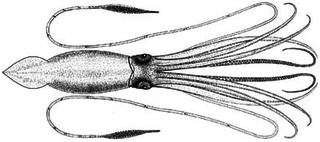
The giant squid is a species of deep-ocean dwelling squid in the family Architeuthidae. Giant squid can grow to a tremendous size, offering an example of deep-sea gigantism: recent estimates put the maximum size at 12 m (39 ft) or 13 m (43 ft) for females and 10 m (33 ft) for males from the posterior fins to the tip of the two long tentacles. The mantle is about 2 m long, and the length of the squid excluding its tentacles rarely exceeds 5 m (16 ft). Claims of specimens measuring 20 m (66 ft) or more have not been scientifically documented.
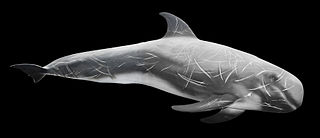
Risso's dolphin is the only species of dolphin in the genus Grampus. It is commonly known as the Monk dolphin among Taiwanese fishermen. Some of the closest related species to these dolphins include: pilot whales, pygmy killer whales, melon-headed whales, and false killer whales.

Four-toothed whales or giant beaked whales are beaked whales in the genus Berardius. They include Arnoux's beaked whale in cold Southern Hemisphere waters, and Baird's beaked whale in the cold temperate waters of the North Pacific. A third species, Berardius minimus, was distinguished from B. bairdii in the 2010s.

Bigfin squids are a group of rarely seen cephalopods with a distinctive morphology. They are placed in the genus Magnapinna and family Magnapinnidae. Although the family is known only from larval, paralarval, and juvenile specimens, some authorities believe adult specimens have also been seen. Several videos have been taken of animals nicknamed the "long-arm squid", which appear to have a similar morphology. Since none of the seemingly adult specimens has ever been captured or sampled, it remains uncertain if they are of the same genus or only distant relatives.

Grimpoteuthis is a genus of pelagic umbrella octopuses known as the dumbo octopuses. The name "dumbo" originates from their resemblance to the title character of Disney's 1941 film Dumbo, having a prominent ear-like fin which extends from the mantle above each eye. There are 13 species recognized in the genus. Prey include crustaceans, bivalves, worms and copepods. The average life span of various Grimpoteuthis species is 3 to 5 years.

Ocythoe tuberculata, also known as the tuberculate pelagic octopus or football octopus, is a pelagic octopus. It is the only known species in the family Ocythoidae.

The great hammerhead is the largest species of hammerhead shark, belonging to the family Sphyrnidae, attaining an average length of 4.6 m (15 ft) and reaching a maximum length of 6.1 m (20 ft). It is found in tropical and warm temperate waters worldwide, inhabiting coastal areas and the continental shelf. The great hammerhead can be distinguished from other hammerheads by the shape of its "hammer", which is wide with an almost straight front margin, and by its tall, sickle-shaped first dorsal fin. A solitary, strong-swimming apex predator, the great hammerhead feeds on a wide variety of prey ranging from crustaceans and cephalopods, to bony fish, to smaller sharks. Observations of this species in the wild suggest that the cephalofoil functions to immobilize stingrays, a favored prey. This species has a viviparous mode of reproduction, bearing litters of up to 55 pups every two years.
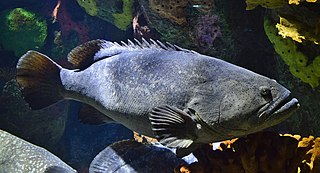
The giant grouper, also known as the Queensland groper, Queensland grouper, brindle grouper or mottled-brown sea bass, is a species of marine ray-finned fish, a grouper from the subfamily Epinephelinae which is part of the family Serranidae, which also includes the anthias and sea basses. It has a wide Indo-Pacific distribution and is one of the largest extant species of bony fish.
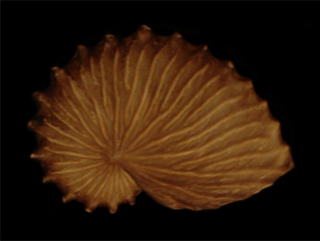
Argonauta bottgeri, also known as Böttger's argonaut, is a species of pelagic octopus belonging to the genus Argonauta. The female of the species, like all argonauts, creates a paper-thin eggcase that coils around the octopus much like the way a nautilus lives in its shell.

The tawny nurse shark is a species of carpet shark in the family Ginglymostomatidae, and the only extant member of the genus Nebrius.

The longnose pygmy shark is a rare species of squaliform shark in the family Dalatiidae and the only member its genus. It is known only from a handful of specimens collected from the cold oceanic waters of the Southern Hemisphere, between the surface and a depth of 502 m (1,647 ft). Reaching 37 cm (15 in) in length, this diminutive shark is characterized by a slender, dark brown body with a very long, bulbous snout. In addition, it has two spineless dorsal fins of nearly equal size, with the origin of the first lying over the pectoral fin bases. The longnose pygmy shark does not appear substantially threatened by fisheries, and has been assessed as Least Concern by the International Union for Conservation of Nature (IUCN).

The quagga catshark is a species of catshark, belonging to the family Scyliorhinidae. A small, slim-bodied shark reaching 37 cm (15 in) in length, it has a distinctive color pattern of narrow, dark brown vertical bars, which resemble those of the quagga. Its head is short and flattened, with a pointed snout tip that is not upturned.

Cephalopods vary enormously in size. The smallest are only about 1 centimetre (0.39 in) long and weigh less than 1 gram (0.035 oz) at maturity, while the largest—the giant and colossal squids—can exceed 10 metres (33 ft) in length and weigh close to half a tonne (1,100 lb), making them the largest living invertebrates. Living species range in mass more than three-billion-fold, or across nine orders of magnitude, from the lightest hatchlings to the heaviest adults. Certain cephalopod species are also noted for having individual body parts of exceptional size. The giant and colossal squids, for example, have the largest known eyes among living animals.

Velodona togata is a species of octopus in the monotypic genus Velodona. First described by Carl Chun in 1915, with a second subspecies discovered by Guy Coburn Robson in 1924, it was named for the distinctive membranes on its arms.

Markham's storm petrel is a species of storm petrel in the family Hydrobatidae. An all-black seabird, Markham's storm petrel is described as hard to differentiate from the black petrel Procellaria parkinsoni in life, and was once described as conspecific, or biologically identical, with Tristram's storm petrel Oceanodroma tristrami. It inhabits open seas in the Pacific Ocean around Peru, Chile, and Ecuador, but only nests in northern Chile and Peru, with 95% of all known breeding populations in 2019 found in the Atacama Desert. First described by British ornithologist Osbert Salvin in 1883, the bird was named in honor of Albert Hastings Markham, a naval officer who collected a specimen off Peru.

The colossal squid is part of the family Cranchiidae. It is sometimes called the Antarctic squid or giant cranch squid and is believed to be the largest squid species in terms of mass. It is the only recognized member of the genus Mesonychoteuthis and is known from only a small number of specimens. The species is confirmed to reach a mass of at least 495 kilograms (1,091 lb), though the largest specimens—known only from beaks found in sperm whale stomachs—may perhaps weigh as much as 600–700 kilograms (1,300–1,500 lb), making it the largest-known invertebrate. Maximum total length has been estimated at 9–10 metres (30–33 ft).

Scyllarides latus, the Mediterranean slipper lobster, is a species of slipper lobster found in the Mediterranean Sea and in the eastern Atlantic Ocean. It is edible and highly regarded as food, but is now rare over much of its range due to overfishing. Adults may grow to 1 foot (30 cm) long, are camouflaged, and have no claws. They are nocturnal, emerging from caves and other shelters during the night to feed on molluscs. As well as being eaten by humans, S. latus is also preyed upon by a variety of bony fish. Its closest relative is S. herklotsii, which occurs off the Atlantic coast of West Africa; other species of Scyllarides occur in the western Atlantic Ocean and the Indo-Pacific. The larvae and young animals are largely unknown.
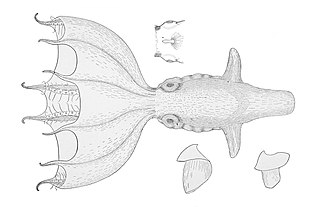
Stauroteuthis syrtensis, also known as the glowing sucker octopus, is a species of small pelagic octopus found at great depths in the north Atlantic Ocean. It is one of a very small number of octopuses to exhibit bioluminescence.

Muusoctopus levis is a species of octopus in the family Enteroctopodidae. It was first described by William Evans Hoyle in 1885 in an article in the Annals and Magazine of Natural History detailing the new species of octopus found on HMS Challenger as part of the Challenger expedition; the type specimen was retrieved from the Southern Ocean. The species is found in subantarctic waters in the Southern Ocean, particularly surrounding Heard Island and Kerguelen Island, but specimens comparable to M. levis have also been found at the Antarctic Peninsula.



















